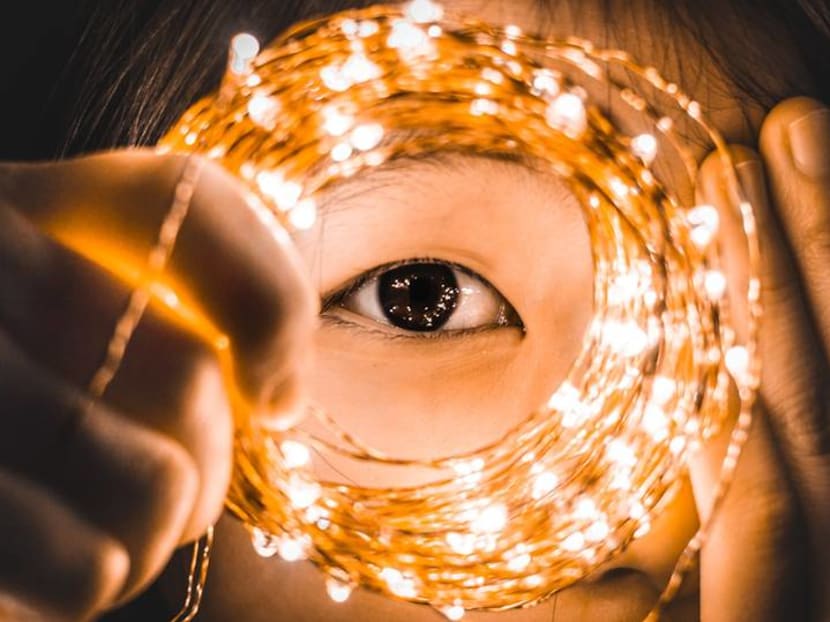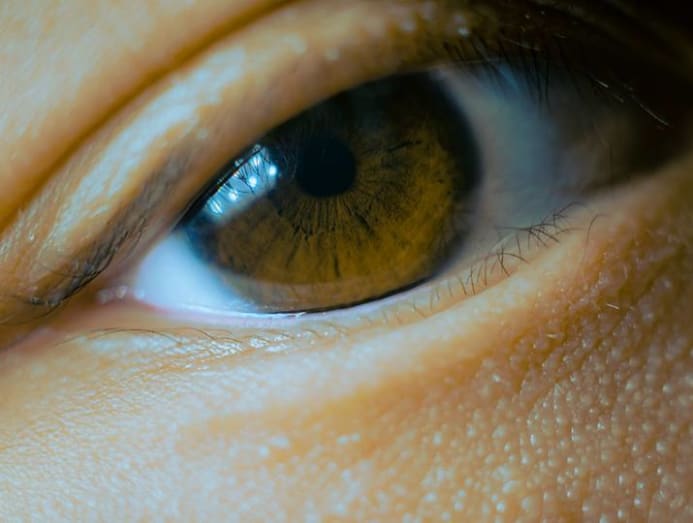Already having trouble reading this? Eye problems could start earlier than expected
Cataracts, glaucoma and presbyopia aren't just old people's issues. With diabetes and myopia on the rise in Singapore, you could develop these earlier than you thought.

(Photo: Unsplash/Nong Vang)
You squint, put on your reading glasses, or grab someone to read for you when it comes to deciphering the fine print on a food label or WhatsApp messages.
If you’re in your 40s, that’s probably presbyopia (or lao hua yan in Chinese) starting to take over your vision.
But there may also be times when your eyes begin to see things. For instance, your eyesight could be marred by “floaters” that look like dark specks or squiggly lines. Or things appear to have taken on a yellow tone, as if your eyes have put on a sepia filter.
And life is all rainbows – or rainbow-coloured circles, to be precise – when that’s what you literally see when you look at bright lights.

It may not occur to you yet but these eye-related issues can have their beginnings in your 40s, and can point to retinal tears, cataracts or glaucoma – conditions you associate with your elderly parents or grandparents.
For instance, cataracts and glaucoma typically manifest in patients in their 50s but when there are diabetes and high myopia present, those eye problems can show up earlier.
And the risks of developing these common eye conditions look high. For instance, 80 per cent to 90 per cent of Singaporean adults are projected to be myopic by 2050, and 15 per cent to 25 per cent of these individuals may have high myopia, said the Ministry of Health.
Furthermore, one million Singaporeans are expected to develop diabetes by 2050, from the 440,000 in 2014, according to HealthHub.
So the earlier you learn about some of these common eye problems, the better you can delay or prevent their onset. Here’s what the experts say.
PRESBYOPIA
Causes: Your eyes are able to focus on near and far objects with the help of tiny ciliary muscles attached to your eyes' natural lenses. These muscles contract when you're using your handheld device, and relax when you're looking out for the bus.
READ: Why you shouldn't use eye drops that are not meant for contact lenses
But as you age, the ciliary muscles weaken, said assistant professor Dr Mohamad Rosman, who is the head and senior consultant of Singapore National Eye Centre’s (SNEC) Refractive Surgery Department. Ageing also affects your eyes’ lenses, causing them to become rigid and less easy to reshape, he explained.
Presbyopia usually begins from age 40 and is often gradual, said Dr Marcus Tan, an associate consultant with National University Hospital’s Department of Ophthalmology. “More than half of people in their 40s would have some form of presbyopia, but not all may be symptomatic.”

Ageing aside, there are other factors that can exacerbate presbyopia, said Dr Yap Zhu Li, a consultant with the Department of Ophthalmology with the SNEC Eye Clinic at Changi General Hospital. “Having certain diseases such as diabetes, multiple sclerosis or cardiovascular risk can increase one’s risk of premature presbyopia,” she said.
If you’re taking certain medicines, such as antidepressants or antihistamines, you may also be more prone to early presbyopia, said Dr Yap.
READ: Living with 'lao hua': How to deal with presbyopia
What are the signs: Your eyes can’t focus on things near you, such as reading the text messages on your handphone. You find yourself having to hold the material further away in order to read more clearly. In addition, your eyes feel unusually strained when reading or doing near-sighted work.
What you can do now: There’s nothing you can do to prevent presbyopia. Still, it is always good to keep to the 20-20-20 rule: For every 20 minutes spent looking at a screen, look at something 20 feet (or 6m) away for 20 seconds.
“Ensure good and comfortable lighting during reading to prevent eye strain,” said Dr Tan, who also advised to keep a healthy and active lifestyle to prevent any chronic conditions such as diabetes.
CATARACTS
Causes: Instead of being clear and transparent, the natural lenses in your eyes turn cloudy over months or years. “The vast majority of cataracts are age-related, so most people start developing them from the age of 50 onwards,” said Dr Yap. “Unfortunately, everyone will eventually develop cataracts as they age, similar to white hair or wrinkles.”
Like presbyopia, certain conditions can create early cataracts. These include high myopia, diabetes, chronic steroid use (such as steroid inhalers for asthma, or steroid creams for eczema), eye trauma and smoking, said Dr Yap.

What are the signs: You may have cataracts, said Dr Tan, if you notice a blurring of vision, glare or sensitivity to light, difficulty seeing or seeing halos around lights at night, or colours appear faded or yellowish.
What you can do now: Sunglasses aren’t just for looking good. In fact, they are important in sunny Singapore, said Dr Tan. “Ultraviolet or UV light from the sun can increase the risk of developing cataracts earlier. This is especially true for patients who are exposed to the sun for long hours during activities such as golfing or sailing,” he said.
Better start wearing those shades because there is no medication to “cure” or slow down cataract formation, said Dr Yap.
READ: How to properly get tested for new glasses so you're not wasting money
GLAUCOMA
Causes: This common eye condition occurs when the optic nerve, which connects the eye to the brain, becomes damaged, said Dr Yap. The damage is usually caused by a build-up of fluid inside the eyeball, which increases the pressure inside the eye. “If not diagnosed and treated early, it can lead to irreversible blindness,” she said.
“Approximately three per cent of people over the age of 50 in Singapore have glaucoma, and this increases to 10 per cent after the age of 70,” said Dr Tan.
Glaucoma can set in earlier if you have diabetes, high myopia, a family history, chronic steroid use or eye trauma.
Interestingly, those with obstructive sleep apnoea are also found to have 10 times the risk of glaucoma, according to the Glaucoma Research Foundation. Its website noted that it might be due to a drop in oxygen levels in the blood, which happens when you stop breathing. “Routine low oxygen concentration in the blood may contribute to the degradation of the optic nerve, potentially leading to glaucoma.”
Those with obstructive sleep apnoea are also found to have 10 times the risk of glaucoma.
What are the signs: Insidiously, glaucoma has no symptoms in its early stages and as such, it is often called the thief of sight, said Dr Tan. “In the later stages, the loss of peripheral vision occurs and in advanced glaucoma, you may knock into objects or have decreased vision.”
When people do have symptoms, said Dr Yap, "it is mostly during the very late stage of the disease when they may notice blurred vision or see rainbow-coloured circles around bright lights". "Acute glaucoma can also develop suddenly and cause a red, very painful eye and blurry vision associated with headache, nausea and vomiting," she said.
READ: Why snoring loudly could be linked to heart disease, hypertension or worse
What you can do now: If you have any of the above risk factors, Dr Yap advised to go for early screening with an ophthalmologist to help with early detection, treatment and prevent possible visual loss. And if you play sports, wear protective eyewear. “A surprisingly frequent cause of eye trauma is being hit in the eye by a badminton shuttlecock,” said Dr Yap.
RETINAL DETACHMENT
Causes: “As you get older, the gel inside the eye called the vitreous shrinks. It can slowly pull away from the inner nerve layer at the back of the eye called the retina,” said Dr Yap, describing posterior vitreous detachment or PVD.
“Visual problems caused by PVD usually improve over a few weeks, and in fact, most people don’t have symptoms, so they may not even realise that it has occurred to them.”
According to Dr Tan, this eye condition usually occurs after age 40 or 50. “More than half of adults above 50 years old would have some form of vitreous degeneration. This is often harmless,” he said.
What are the signs: It is normal to sometimes see what look like dark specks, squiggly worms, flying hairs or spider webs in your vision. But if you suddenly see a lot more of these floaters or even flashes of light, it could be vitreous degeneration caused by PVD, said Dr Yap.
What you can do now: “Direct injury to the eye from sports or accidents can cause retinal tears or detachment,” said Dr Tan. “As such, wear appropriate protective eyewear when playing high-velocity racquet games such as squash.”





